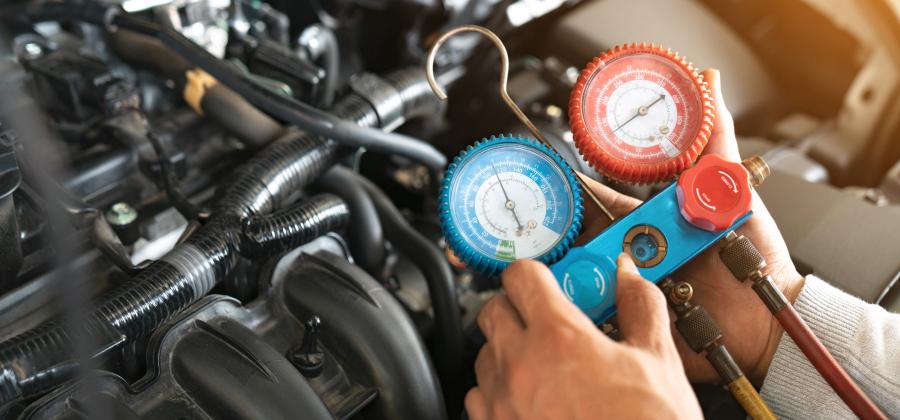

No sweat - ac troubleshooting
Summer is right around the corner and temps are already in the mid-80°F/30°C range in some parts of North America. What better time for a collection of air conditioning diagnostic tips? Some of these tips will require test equipment, others will require your basic senses and experience. A word to the wise: air conditioning systems operate under high pressures and extremes of temperatures, and the system is surrounded by moving parts that can pose danger to the technician and any bystanders. Also, note that this diagnostic information is not specific to one vehicle. Consult ALLDATA for exact procedures for your problem car or truck.
That said, you may find these tips very useful on virtually all vehicles.
If you’re reading this, you may have a vehicle in your shop with a complaint of “no cold air coming from the dash vents.” To diagnose lack of cooling, you’ll need to determine if the problem falls into one of these areas:
- The liquid-vapor cycle system, which consists of the following components:
- Compressor
- Condenser
- Evaporator and associated condensate drain
- Expansion valve/orifice tube or equivalent
- Receiver/filter/dryer or accumulator/filter/dryer
- Metal and rubber tubing and associated insulation
- Fan(s) for airflow through the condenser and evaporator (blower motor)
- Electronic control circuits for the compressor (often part of the Powertrain Control electronics)
- Electronic control circuits for the condenser fan(s)
- Chin spoilers, grill shutters, and bumper ducting for condenser airflow
- The air distribution system, which consists of the following components:
- Blower motor (failure of which also affects the liquid-vapor cycle)
- Blend doors for temperature control
- Hot water valve for temperature control on a few systems
- Mode doors for control of air direction and destination
- Ducting and associated insulation
- Electronic control circuits for blower speed, mode and blend doors (sometimes integrated with compressor control)
The first step in diagnosing “it’s getting hot in here” complaints is to find out if the liquid-vapor cycle system is working properly. Before we can do that, we need to understand how it works. You cannot successfully troubleshoot many A/C problems without understanding the physics involved and the function of each component.
First, how does A/C work?
The liquid-vapor cycle air conditioning system moves heat from one area to another. Whatever heat is absorbed by the evaporator from the passenger compartment has to be released into the atmosphere by the condenser. The refrigerant (usually R134a, sometimes R1234yzf) is used to move that heat. The heat transfer occurs through the phase change of the refrigerant from liquid to gas and back to liquid. There is no temperature change until a phase change is complete.
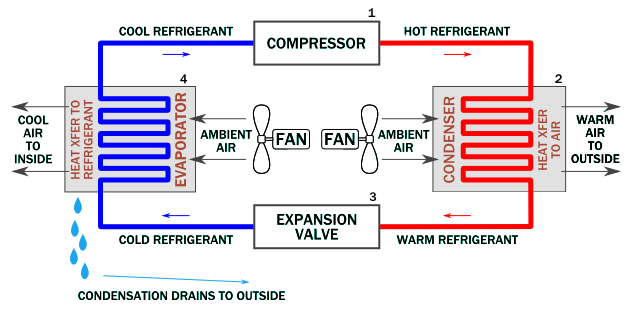
The system can be divided in half between the high pressure and low pressure “sides.” The dividing lines are the compressor and the expansion valve/orifice tube. Without both the compressor and the expansion valve/orifice tube being fully functional, there will be no cooling.
A side note on thermal expansion valves/orifice tubes:
- They control the amount of refrigerant entering the evaporator. Too little flow, and cooling is reduced. Too much flow and there is potential for liquid entering the compressor which may cause serious damage.
- They need to be properly sized for the application.
- They maintain the critical pressure difference between the condenser (high pressure) and the evaporator (low pressure).
The compressor just moves the refrigerant along; it cannot compress a liquid, so it draws gasses from the vapor side of the system. Compressing gas produces heat; to reduce this, move the gas to the condenser. This is where high-pressure gas undergoes a phase change to a high-pressure liquid. The liquid now moves through a thermal expansion valve, orifice tube, or equivalent. This causes the pressure to drop and the liquid turns to vapor by boiling at low temperature. This second phase change absorbs heat from the air surrounding the evaporator, providing cool air to the interior.
Without proper airflow through both the condenser and the evaporator, the phase changes cannot occur. Debris blocking the fins on either component will reduce or eliminate cooling capability and it may result in compressor damage.
Let's start with the “Grab” Test
Armed now with a basic understanding of how the system functions, we can perform some quick checks to determine why this vehicle is not cooling properly. With all switches set to the appropriate positions for A/C and the engine running at 1,500 RPM, allow at least 5 minutes for the system to reach maximum cooling. While waiting, make sure that the condenser fan(s) are operational AND the airflow across the condenser is moving opposite to the normal direction the car moves while driving (air should blow toward the engine compartment). Keep in mind people have done wiring repairs with the electric fans wired backward or the wrong engine driven fans installed. The system may cool while stopped but when moving the opposite direction airflows cancel each other out. Also make sure the blower inside the car is moving air.
Once the system is ready for testing, use an infrared thermometer (preferred) or careful application of your fingers to verify that the low-pressure side is cold, and the high-pressure side is hot. The hoses and tubing for the low-pressure side can be identified by their much larger diameter when compared to the high-pressure side hoses and tubing. In a properly operating system you will probably see water condensing on the outside of the low-pressure tubing. Any cold spots on the high-pressure side are abnormal and usually evidence of partially collapsed tubing or component clogging. These restrictions create mini “expansion valves” in the high-pressure side, leading to the cold spots. Warm low-pressure hoses and lines can indicate low or high refrigerant levels, stuck-open expansion valves, defective compressor or electronic compressor control circuit problems
Don’t overlook the duct work. Every duct should be properly connected and not restricted or collapsed.
If the vehicle passes the “grab” test, then focus your attention on the air distribution system. If the customer is also complaining about poor airflow and poor heater operation, then look for debris clogging of the evaporator or cabin air filter. Don’t overlook the ductwork. Every duct should be properly connected and not restricted or collapsed. Make sure you have all your ducts in a row.
Check your blend and mode doors. Is the blend door adding hot air to the mix? Are the mode doors sending the air somewhere other than the customer’s face? On dual-temperature systems is one side of the dash warm and the other cold?
Is the blower motor fully functional on all speeds? Tech Tip: some vehicles will not allow the compressor to work unless the blower and condenser fans are fully operational. Lack of airflow on either fan can cause system pressures to rise excessively.
What if the system fails the “grab” test?
Since we know that the system will not function without the proper levels of refrigerant, a failed “grab” test is cause for getting out the A/C pressure gauges. Start by checking static pressure. Hook up the pressure gauges to a completely shut off vehicle. If it is a hybrid or EV you may have to go through some extra steps to confirm every part of the air conditioning is shut off. Although there are charts available to determine exactly what the static pressure should be, here’s a rule of thumb. At normal room temperature, the static (system OFF) pressure on both the low and high sides should be about 70-80 PSI on a properly charged system.
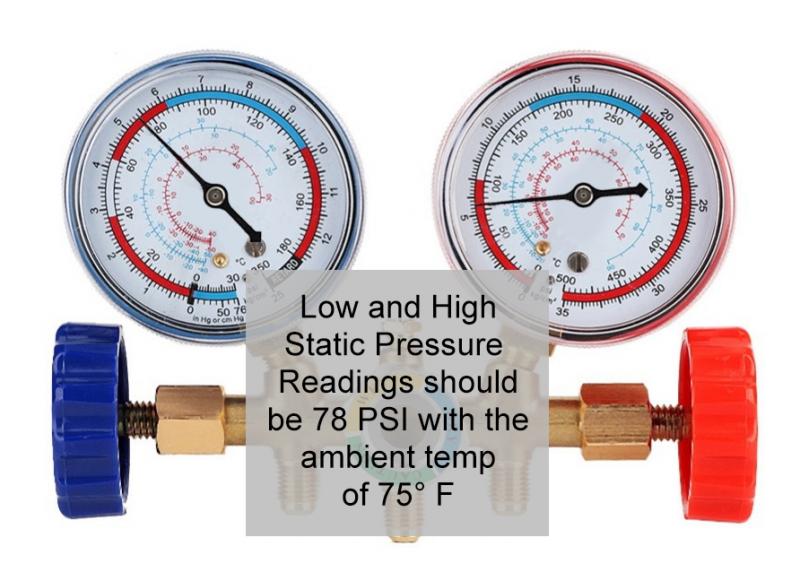
The static pressures will be lower if the system is colder; at 50˚F/10˚C the static pressure of a fully charged system will be about 45 psi. At 100˚F/37.8˚C the static pressure will rise to approximately 124 psi. If you’re nowhere near normal values do not try to add a little or let some out to get to a proper value. The only accurate way to get to a proper level is to recover the refrigerant and charge with the manufacturer’s specified weight of the specified refrigerant. Today’s systems hold so little refrigerant that you must be accurate in filling the system or risk damage or poor system performance.
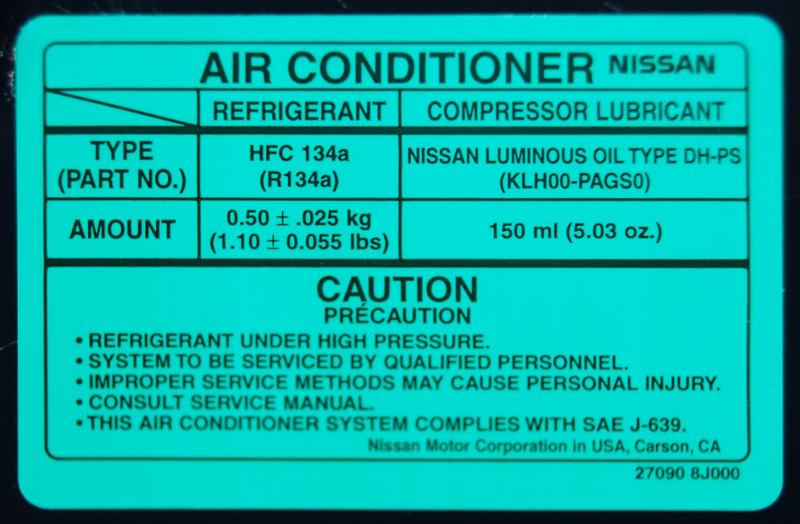
If you see evidence of severe leakage, or components that have been replaced, the oil level may be low. See the manufacturer’s procedure for checking the system oil level. If oil is added, it must be the proper type for the compressor. Hybrids and EV’s often use a very special oil that is non-conductive. Adding the wrong oil to the A/C on some Hybrids could be harmful to your wallet; some sources say you must replace all A/C components if that occurs. It stands to reason that you may want to have a separate gauge set for use with these vehicles to avoid oil contamination.
What if the static pressures are normal?
At this point you need to head to the manufacturer’s diagnostic information. There may be DTC’s that will help you find the cause. Looking at PID values is valuable. The system may be full, but a faulty refrigerant pressure sensor signal value is preventing normal operation. Checking PID values would reveal the pressure being reported as being too low or too high for the system to allow the compressor to function.
It is important for you to understand how the air conditioning works on the vehicle you’re diagnosing. Know the specifics. Not all compressors have clutches. Some cars won’t allow A/C to work if there are engine trouble codes. The compressor may be controlled by the PCM or it may be controlled by the HVAC dash module. Don’t assume that because you know how A/C works on a Ford truck that you also know how it works on a Ford Mustang. And of course, there are changes over the years to consider.
It passed the “grab test”, my ducts are fine, my blend doors are not adding heat, and yet the system just isn’t cool enough.
Once again, refer to the diagnostic information from the vehicle manufacturer. Verify that the pressures fall into the proper range. Charts like these depict the proper system pressures when the system is operating. You may have a compressor that is badly worn, or something as simple as two pounds of dog hair in the evaporator.
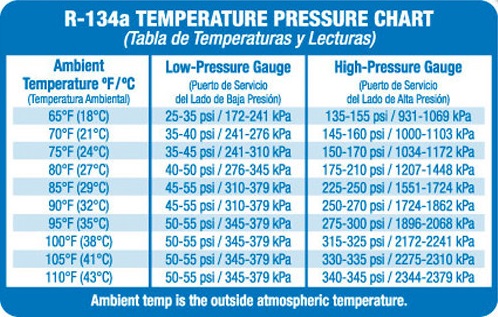
What about COVID-19 and cabin air filters?
Cabin air filters often get neglected. Failure to service the filter at the recommended intervals can affect air conditioner and heater operation. But that filter can also be a biohazard. Handle it with care, wear proper Personal Protection Equipment and dispose of the filter inside a plastic bag which is securely closed before placing in the trash.
You’re ready to tackle air conditioning Service and Repair
Follow these tips and you’ll be on your way to a profitable season of A/C repair. If you have any tips to share or horror stories of A/C repair, please send them our way. We will share them in a follow-up article. Pictures too, if you have them.
Want to see how ALLDATA can improve tech efficiency? Check out our suite of products, each designed to contribute to both shop efficiency and productivity.
If you would like to read more articles like this one please subscribe to ALLDATA News.
See more ALLDATA articles





